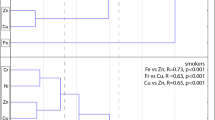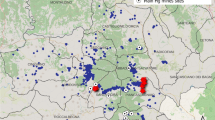Abstract
Objective: The present study was initiated to establish the reference levels of Co, Cu, Mn, and Ni in urine of women in the general Japanese population. Methods: Stored urine samples were subjected to the analysis. The samples were collected from 1,000 adult women all over Japan, who had no occupational exposure to these elements. Co, Cu, Mn, and Ni in urine were analyzed by graphite furnace atomic absorption spectrometry. The concentrations were distributed log-normally, and were presented in terms of geometric mean (GM) and geometric standard deviation, as observed or after correction for creatinine concentration or a specific gravity of urine of 1.016. Results: The GM values of observed levels (i.e., with no correction for urine density) and of the levels after correction for creatinine (cr) concentration (values in parenthesis) were 0.68 g/l (0.60 μg/g cr) for Co, 13.4 g/l (11.8 g/g cr) for Cu, 0.14 μg/l (0.12 g/g cr) for Mn and 2.1 g/l (1.8 g/g cr) for Ni. There was a life-long age-dependent increase in Cu. Mn levels reached the maximum at 60 to 69 years of ages. In contrast, age-dependency was not substantial in Co and Ni. Conclusions: Comparison with values reported in literatures for other areas showed that Co and Ni levels in urine of Japanese women are higher than, Cu level is comparable with, and Mn level is lower than others. The reasons for high Co and Ni levels deserve further study.

Similar content being viewed by others
References
Acheson KJ, Campbell IT, Edholm OG, Miller DS, Stock MJ (1980) The measurement of food and energy intake in man—an evaluation of some techniques. Am J Clin Nutr 33:1147–1154
Alexandersson R (1988) Blood and urinary concentrations as estimators of cobalt exposure. Arch Environ Health 43:299–303
Alimonti A, Petrucci F, Krachler M, Bocca B, Caroli S (2000) Reference values for chromium, nickel and vanadium in urine of youngsters from the urban area of Rome. J Environ Monit 2:351–354
Apostoli P (1992) Criteria for the definition of reference values for toxic metals. Sci Total Environ 120:23–37
Apostoli P, lucchini r, Alessio L (2000) Are current biomarkers suitable for Assessment of manganese exposure in individual workers? Am J Ind Med 37:283–290
Bast-Pettersen R, Ellingsen DG, Hetland SM, Thomassen Y (2004) Neuropsychological function in manganese alloy plant workers. Int Arch Occup Environ Health 77:277–287
Beneš B, Spěváčková V, Šmíd J, Čejchanová M, Kaplanová E, Černá M, Gajewská V, Blatný J (2002) Determinatnion of normal concentration levels of Cd, Pb, Hg, Cu, Zn and Se in urine of the population in the Czech Republic. Cent Eur J public Health 1–2:3–5
Bingham SA (1987) The dietary assessment of individuals; methods, accuracy, new techniques and recommendations. Nutr Abst Rev Ser A 57:705–742
Buchwald H (1964) The expression of urine analysis results–Observations on the use of specific gravity correction. Ann Occup Hyg 7:125–136
Center for Disease Control and Prevention (CDCP), Department of Health and Human Services, USA (2005) Cobalt. In: Third national report on human exposure to environmental chemicals (NCEH Pub. No. 05-0570). National Center for Environmental Health, Atlanta, GA 30341–3724, USA pp34–37
Council for Science and Technology, Ministry of Education, Culture, Sports, Science and Technology, Japan (2005) The fifth and enlarged version of Standard tables of food composition in Japan. National Printing Bureau, Tokyo
Ellingsen DG, Hetland SM, Thomassen Y (2003) Manganese air exposure assessment and biological monitoring in the manganese alloy production industry. J Environ Monit 5:84–90
El-Safty IAM, Gadallah M, Shafik A, Shouman E (2002) Effect of mercury vapour exposure on urinary excretion of calcium, zinc and copper: relationship to alterations in functional and structural integrity of the kidney. Toxicol Ind Health 18:377–388
Ezaki T, Tsukahara T, Moriguchi J, Furuki K, Fukui Y, Ukai H, Okamoto S, Sakurai H, Honda S, Ikeda M (2003) No clear-cut evidence for cadmium-induced tubular dysfunction among over 10,000 women in the Japanese general population; a nationwide large-scale survey. Int Arch Occup Environ Health 76:186–196
Ferdenzi P, Giaroli C, Mori P, Pedroni C, Piccinini R, Ricci R, Sala O, Veronesi C, Mineo F (1994) Cobalt powdersintering industry (stone cutting diamond wheels); a study of environmental-biological monitoring, workplace improvement and health surveillance. Sci Total Environ 150:245–248
Ferri F, Candela S, Bedogni L, Piccinini R, Sala O (1994) Exposure to cobalt in the welding process with stellite. Sci Total Environ 150:145–147
Forte G, Bocca B, Senofonte O, Petrucci F, Brusa L, Stanzione P, Zannino S, Violate N, Alimonti A, Sancesario G (2004) Trace and major elements in whole blood, serum, cerebrospinal fluid and urine of patients with Parkinson’s disease. J Neural Transm 111:1031–1040
Health and Welfare Statistics Association, Japan (2005) Life tables. J Health Welfare Statistics 52:64–66
Institute of Medicine (1998) 9. Vitamin B12. In: Dietary reference intakes for thiamin, riboflavin, niacin, vitamin B6, folate, vitamin B12, pantothenic acid, biotin, and choline. National Academy, Washington, DC, pp 306–356
Institute of Medicine (2001) Copper, Manganese and Nickel. In: Dietary reference intakes for vitamin A, vitamin K, arsenic, boron, chromium, copper, iodine, iron, manganese, molybdenum, nickel, silicon, vanadium, and zinc. National Academy, Washington, DC, pp 224–257, 394–419, and 521–529
Jackson S (1966) Creatinine in urine as an index of urinary excretion rate. Health Phys 12:843–850
Jacobs JJ, Skipor AK, Doorn PF, Campbell P, Schmalzried TP, Black J, Amstutz HC (1996) Cobalt and chromium concentrations in patients with metal on metal total hip replacements. Clin Orthop Relat Res 329(Suppl):S256–S263
Järvisalo J, Olkimuora M, Kiilunen M, Kivistö H, Ristola P, Tossavainen A, Aitio A (1992) Urinary and blood manganese in occupationally nonexposed populations and in manual metal arc welders of mild steel. Int Arch Occup Environ Health 63:495–501
Keen CL, Zidenberg-Cherr S (1996) 33. Manganese. In: Ziegler EE, Filer LJ Jr (eds) Present knowledge in nutrition, 7th edn. ILSI, Washington DC, pp 334–343
Kraus T, Schramel P, Schaller KH, Zöbelein P, Weber A, Angerer J (2001) Exposure assessment in the hard metal manufacturing industry with special regard to tungsten and its compounds. Occup Environ Med 58:631–634
Kristiansen J, Christensen JM, Iversen BS, Sabbioni E (1997) Toxic trace element reference levels in blood and urine; influence of gencer and lifestyle factors. Sci Total Environ 204:147–160
Lander F, Kristiansen J, Lauritsen JM (1999) Manganese exposure in foundry furnacemen and scrap recycling workers. Int Arch Occup Environ Health 72:546–550
Levine L, Fahy JP (1945) Evaluation of urinary lead concentrations. I. The significance of specific gravity. J Ind Hyg Toxicol 27:217–223
Li GJ, Zhang L-L, Lu L, Wu P, Zheng W (2004) Occupational exposure to welding fume among welders: Alterations of manganese, iron, zinc, copper, and lead in body fluids and the oxidative stress status. J Occup Environ Med 46:241–248
Linder MC (1996) 30. Copper. In: Ziegler EE, Filer LJ Jr (eds) Present knowledge in nutrition, 7th edn. ILSI, Washington DC pp 307–319
Loranger S, Zayed J (1995) Environmental and occupational exposure to manganese; a multimedia assessment. Int Arch Occup Environ Health 67:101–110
Milne DB, Nielsen FH (1996) Effects of a diet low in copper on copper-status indicators in postmenopausal women. Am J Clin Nutr 63:358–364
Ministry of Health, Labour and Welfare, Japan (2006) National health and nutrition survey in Japan, 2003. Daiichi Shuppan Publishers, Tokyo. pp292 and 301
Minoia C, Sabbioni E, Apostoli P, Pietra R, Pozzoli L, Gallorini M, Nicolaou G, Alessio L, Capodaglio E (1990) Trace element reference values in tissues from inhabitans of the European Community 1. A study of 46 elements in urine, blood and serum of Italian subjects. Sci Total Environ 95:89–105
Moriguchi J, Ezaki T, Tsukahara T, Furuki K, Fukui Y, Okamoto S, Ukai H, Sakurai H, Ikeda M (2005a) α1-Microglobulin levels and correlation with cadmium and other metals in urine of non-smoking women among general populations in Japan. Toxicol Environ Chem 87:119–133
Moriguchi J, Ezaki T, Tsukahara T, Fukui Y, Ukai H, Okamoto S, Shimbo S, Sakurai H, Ikeda M (2005b) Decrease in urine specific gravity and urinary creatinine in elderly women. Int Arch Occup Environ Health 78:438–445
Mukherjee S, Rodrigues E, Aeschliman DB, Houk RS, Palmer LJ, Woodlin MA, Weker R, Chrisiani DC (2005) Urinary metal and polycyclic aromatic hydrocarbon biomarkers in boilermakers exposed to metal fume and residual oil fly ash. Am J Ind Med 47:484–493
Myers JE, Thompson ML, Naik I, Theodorou P, Esswein E, Tassell H, Daya A, Renton K, Spies A, Paicker J, Young T, Jeebhay M, Ramushu S, London L, Rees D (2003) The utility of biological monitoring for manganese in ferroalloy smelter workers in South Africa. Neurotoxicology 24:875–883
Nielsen FH (1996) 35. Other trace elements: Nickel. In: Ziegler EE, Filer LJ Jr (eds) Present knowledge in nutrition, 7th edn. ILSI, Washington DC, pp 360–364
Paschal DC, Ting BG, Morrow JC, Pirkle JL, Jackson RL, Sampson EJ, Miller DT, Caldwell KL (1998) Trace metals in urine of United States residents: Reference range concentrations. Environ Res A76:53–59
Prasad AS (1993) Essentiality and toxicity of zinc. Scand J Work environ Health 19(Suppl 1):134–136
Rainsford SG, Lloyd Davies TA (1965) Urinary excretion of phenol by men exposed to vapour of benzene; a screening test. Br J Ind Med 22:21–26
Sadek AH, Rauch R, Schulz PE (2003) Parkinsonism due to manganism in a welder. Int J Toxicol 22:393–401
Scansetti G, Botta GC, Spinelli P, Reviglione L, Ponzetti C (1994) Absorption and excretion of cobalt in the hard metal industry. Sci Total Environ 150:141–144
Schaffer AW, Pilger A, Engelhardt C, Zweymueller K, Ruediger HW (1999) Increased blood cobalt and chromium after total hip replacement. Clin Toxicol 37:839–844
Schaller KH, Angerer J, Drexler H (2002) Quality assurance of biological monitoring in occupational and environmental medicine. J Chromat B 78:403–417
Smith-Sivertsen T, Tchachtchine V, Lund E, Bykov V, Thomassen Y, Norseth T (1998) Urinary nickel excretion in populations living in the proximity of two Russian nickel refineries: A Norwegian-Russian population-based study. Environ Health Perspect 106:503–511
Stridsklev IC, Schaller K-H, Langård S (2004) Monitoring of chromium and nickel in biological fluids of stainless steel welders using the flux-cored-wire(FCW) welding method. Int Arch Occup Environ Health 77:587–591
Sugita M, Tsuchiya K (1995) Estimation of variation among individuals of biological half-times of cadmium calculated from accumulation data. Environ Res 68:31–37
Sunderman FW Jr (1993) Biological monitoring of nickel in humans. Scand J Work Environ Health 1:34–38
Tsukahara T, Ezaki T, Moriguchi J, Furuki K, Fukui Y, Ukai H, Okamoto S, Sakurai H, Ikeda M (2003) No significant effect of iron deficiency on cadmium body burden or kidney dysfunction among women in the general population in Japan. Int Arch Occup Environ Health 76:275–281
Uauy R, Olivares M, Gonzalez M (1998) Essentiality of copper in humans. Am J Clin Nutr 67 (Suppl):952S–959S
White MA, Dyne D (1994) Biological monitoring of occupational cobalt exposure in the United Kingdom. Sci Total Environ 150:209–213
World Health Organization (1996) Biological Monitoring of Chemical Exposure in the Workplace. Vol. 2. Chapter 1.3 Cobalt and Chapter 1.4 Nickel. World Health Organization, Geneva
Yamagami T, Ezaki T, Moriguchi J, Fukui Y, Okamoto S, Ukai H, Sakurai H, Aoshima K, Ikeda M (2006) Low-level cadmium exposure in Toyama City and its surroundings in Toyama prefecture, Japan, with references to possible contribution of shellfish intake to increase urinary cadmium levels. Sci Total Environ (in press)
Acknowledgments
A part of this study was supported by research grants from the Ministry of Health, Labour and Welfare, the Government of Japan for the fiscal years 2005 and 2006. Thanks are due to Professor F. Kayama, Jichi Medical School, Tochigi, Japan, and the administration and the staff of Kyoto Industrial Health Association, Kyoto, Japan, for their interest in and support to this work. The authors are grateful also to Toray Research Center, Ohtsu, Japan, for the analyses of urine for Co, Cu, Mn and Ni.
Author information
Authors and Affiliations
Corresponding author
Rights and permissions
About this article
Cite this article
Ohashi, F., Fukui, Y., Takada, S. et al. Reference values for cobalt, copper, manganese, and nickel in urine among women of the general population in Japan. Int Arch Occup Environ Health 80, 117–126 (2006). https://doi.org/10.1007/s00420-006-0109-4
Received:
Accepted:
Published:
Issue Date:
DOI: https://doi.org/10.1007/s00420-006-0109-4




